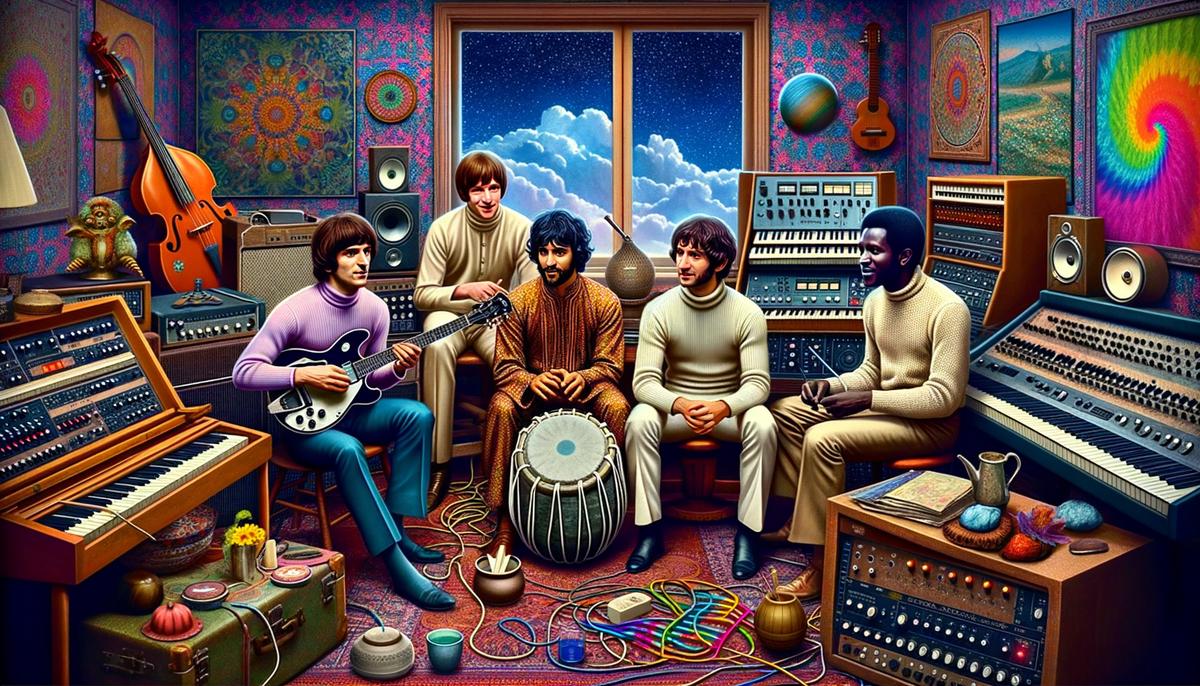The Beatles' Transition
By mid-1966, the Beatles felt trapped in Beatlemania's whirlwind. Performing to screaming audiences that drowned out their music wasn't cutting it anymore. They craved artistic freedom beyond concert stages and teen hysteria.
Their sonic revolution began when they stepped off the tour bus and into the studio. Without the pressure to churn out songs playable with just guitars and drums, they explored a kaleidoscope of instruments – from classical orchestras to sitars. The studio became their playground, filled with vintage sounds and innovative recording techniques brought to life by George Martin and Geoff Emerick.
Freed from touring constraints, the Beatles cooked up new musical recipes. They introduced fictional personas with Sgt. Pepper's, pushing lyrical boundaries. Lennon and McCartney, with Harrison's occasional spiritual flair, cracked open song structures, blending rock with psychedelia and avant-garde touches.
This breakaway allowed Sgt. Pepper's to unfold as a vibrant collection of ideas rather than a compilation of singles. Every track brought something new – from McCartney's narrative in "She's Leaving Home" to the eclectic mix of harpsichords and rock sounds across the album.
The Beatles weren't just riding a wave of change; they were making waves. Each twist of the album resonated with the '60s movement – freedom, exploration, and rebellion wrapped in catchy harmonies and deep lyrics. That's how they painted their masterpiece on the canvas of Sgt. Pepper's Lonely Hearts Club Band, an album that would ultimately leave lasting colors on the rock 'n' roll scene.
Innovative Recording Techniques
The studio was where the Beatles sculpted Sgt. Pepper's new sound universe. Producer George Martin and engineer Geoff Emerick waved their magic wands, forever altering rock music's landscape.
Traditional rock instrumentation boundaries vanished. In their place came a diverse orchestra – sitars, French horns, even harps! The studio became a smorgasbord of sound, with every unconventional choice on the menu. Mellotrons pumped out funky, haunting vibes no one had heard before.
This sonic alchemy wasn't just tinkering. The lads experimented like mad scientists, concocting unusual sound potions. Classical effects meshed perfectly with the psychedelic vibe flooding the airwaves. Lennon's "A Day in the Life," with its swirling orchestral crescendos, leaves listeners breathless.
They fiddled with tape too – reversing, speeding up, and slowing it down. The result? Harmonies shimmering like northern lights. Recording "Lucy in the Sky with Diamonds" involved a three-note riff that could teleport you to a dreamy, kaleidoscope world.
"Lucy in the Sky with Diamonds" captures the essence of a '60s acid trip, a sonic whirlpool of colorful imagery and surrealist vibes.
Sgt. Pepper's was no throwaway cluster of singles. It was a brave, unified declaration of artistry – a complete icon of musical evolution. Crafted carefully, it burst open album conventions, inviting listeners to experience a whole musical universe unfolding in psychedelic unity.
Every sound was deliberate, every ornamental flourish felt. Martin and Emerick's experimental techniques didn't just help create a transcendent auditory wonderland; they transformed albums from mere collections of tracks into vibrant galleries of music.

Cultural Impact and Reception
Sgt. Pepper's Lonely Hearts Club Band didn't just shake up the music scene; it exploded in the world's cultural sky. As the Beatles unleashed their kaleidoscopic sound trip in 1967, they launched an era. This was the soundtrack that painted the Summer of Love. Critics declared it a 'decisive moment in the history of Western civilization.'
The album didn't just speak to the movement; it was the movement. It pushed the boundaries of what an album could be, breaking free from societal restraints and yearning for something deeper. The tunes resonated as anthems for a generation tuned into change, harmony, and a dash of rebellious spirit.
A phenomenal wave rolled over the consciousness of young and old alike. Beneath the poppy melodies lay a daring challenge to venture into uncharted territories – a reflection of those heady days when rules were made to be rewritten.
- Sgt. Pepper's topped the charts for:
- 27 weeks in the UK
- 15 weeks in the US
- Fans didn't just buy the record; they devoured it, spinning it until the grooves were etched into their memories.
The record's vivid cover was a declaration matching the sonic adventure within. The influence seeped beyond the tracks; fashion went vibrant, art grew bold, and consciousness sought new horizons.
This wasn't just an album; it was a psychedelic beacon guiding a fleet of rock bands. Doors were flung open, inspiring the Rolling Stones, the Beach Boys, and many more to drift into uncharted seas. When you tuned into Sgt. Pepper, you tuned into the universal hum of a cultural renaissance.
Musical and Lyrical Themes
Sgt. Pepper's Lonely Hearts Club Band is a smorgasbord of sounds so eclectic, even a jukebox would feel envious. The Beatles ventured far beyond traditional rock 'n' roll, surfing both psychedelic and introspective seas.
"Lucy in the Sky with Diamonds" captures the essence of a '60s acid trip, a sonic whirlpool of colorful imagery and surrealist vibes. Lennon's vocals float across a landscape painted with vivid and abstract imagery, inviting listeners to explore their imagination.
"A Day in the Life" takes listeners on a rollercoaster ride through the mundane and existential. Lennon's coolly detached reflections blend seamlessly into McCartney's lively interlude, crashing together in a climactic crescendo. It's a radical experiment mirroring symphony, pop, and reflective poetry.
The album threads social awareness throughout. "She's Leaving Home" comments on the generational chasm, while "When I'm Sixty-Four" ponders time's march with a playful wink.
"Within You Without You," thanks to Harrison's spiritual expedition, explores Indian soundscapes and Eastern philosophy. The sitar strings pull listeners into a meditative experience, reminding us that music is the universal language.
Each track unfolds a new layer of musical evolution. Jazz, rock, classical, Indian, and baroque pop weave together, creating a story as diverse and unpredictable as the times themselves.
Sgt. Pepper's turns the usual rock album structure on its head. It flings open a world where playful absurdity sits alongside poignant truths, where melody and madness coexist harmoniously. It's rock 'n' roll's grand invitation to break barriers and redefine the familiar.

The Beatles' journey through the creation of Sgt. Pepper's Lonely Hearts Club Band was a testament to their artistic liberation. This album wasn't just a collection of songs; it was a vibrant declaration of creativity and change, leaving an indelible mark on music and culture alike.
- Tynan K. Times of London. 1967.
- Bernstein L. Cited in: The Beatles. Sgt. Pepper's Lonely Hearts Club Band. Apple Corps Ltd.; 2017.
- Winner L. The New Yorker. 1967.
- Rolling Stone. 500 Greatest Albums of All Time. 2003.
